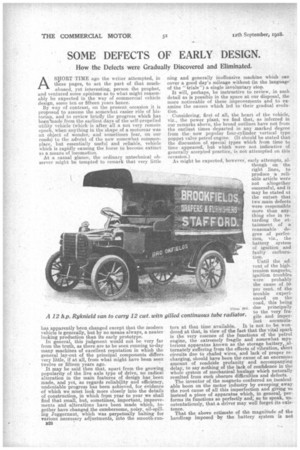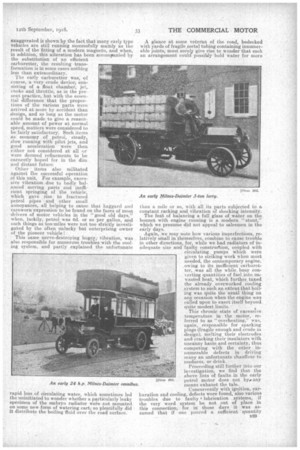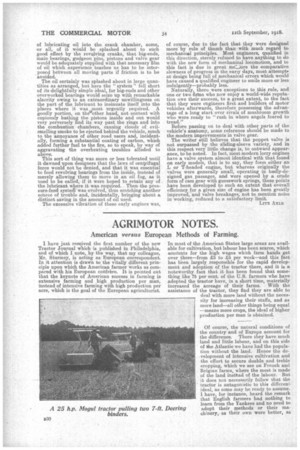SOME DEFECTS OF EARLY DESIGN.
Page 8

Page 9

Page 10

If you've noticed an error in this article please click here to report it so we can fix it.
How the Defects were Gradually Discovered and Eliminated.
ASHORT TIME ago the writer attempted, in these pages, to act the part of that muchabused, yet interesting, person the prophet, and ventured some opinions as to what might reason
ably ably be expected n the way of commercial vehicle design, some ten or fifteen years hence. By way of contrast, on the present occasion it is proposed to assume the somewhat easier role of historian, and to review briefly the progress which has beeninade from the earliest days of the self-propelled utility vehicle (which is after all a not very remote epoch when anything in the shape of a motorcar was an object of wonder, and sometime S fear, on our roads) to thc advent of the now somewhat commonplace, but essentially useful and reliable, vehicle which is rapidly causing the horse to become, extinct as a means of locomotion.
At a casual glance, the ordinary untechnical observer might be tempted to remark that very little has apparently been changed except that the modern vehicle is generally, but by no means always, a neater looking production than its early prototype. In general, this judgment would not be very far from the truth, as there are to be seen running to-day many machines of excellent reputation in whieh the general lay-out of the principal components differsvery little, if at all, from what might have been seen twelve or fifteen years ago. It may be said then that, apart from the growing popularity of the live axle type of drive, no radical alteration in the main features of design has been made, and yet, as regards reliability and efficiency, undeniable progress has been achieved, for evidence of which we must look more closely into the details of construction, in which from year to year we shall find that small, but, sometimes, important, improvements and alterations have been made which, together have changed the cumbersome, noisy, oil-spilling Juggernaut, which was perpetually halting for various necessary adjustments, into the smooth-run B28 fling and generally inoffensive machine whieh can cover a good day's mileage without (in the language of the " trials") a single involuntary stop.
It will, perhaps, be instructive to review, in such detail as is possible in the space at our disposal, the more noticeable of these improvements and to examine the causes which led to their gradual evolution.
Considering, first of all, the heart of the vehicle, viz., the power plant, we find that, as inferred in our remarks above, the broad outlines have not from the earliest times departed in any marked degree from the now .popular four-cylinder vertical type popPet valve petrol engine. (It. should be stated that the discussion of special types which from time to time appeared, but which were not indicative of generally accepted practice, is not attempted on this occasion.) As might be expected, however, early attempts, al though on the right lines, to produce a reliable article were not altogether successful, and it may be stated at the outset that two main defects were responsible more than any thing else in retarding the at tainment of a reasonable degree of perfec tion viz., the battery system of ignition and faulty carburation.
Until the advent of the high tension magneto, ignition troubles were probably the cause of 50 per cent. of the trouble experi enced on the road, this being' due principally to the very fra gile . and imperfect accumula tors at that time available. It is not to be won dered at that, in view of the fact that the vital spark is the very essence of the functions of the petrol engine, the extremely fragile and somewhat mys terious apparatus known as the storage battery ,alter/lately suffering from the effects of vibration, short circuits due to chafed wires, and lack of proper re charging, should have been the cause of an enormous amount of roadside profanity and accompanying
delay, to say -nothing of the lack of confidence in the whole system of mechanical haulage which naturally resulted from such obscure difficulties and defects. The inventor of the magneto conferred an incalcul able boon on the motor industry by sweeping. away the root cause of all this imperfection and giving us
instead a piece of apparatus which, in general, performs its functions so perfectly and; so to speak, unostentatiously, that a driver may well forget its existence. That the above estimate of the magnitude of the handicap imposed by the battery system is not
exaggerated is shown by the fact that many early type vehicles are still running successfully mainly as the result of the fitting of a modern magneto, and when, in addition, this alteration has been accompanied by the substitution of an efficient carburetter, the resulting transformation is in some cases nothing less than extraordinary.
The early carburetter was, of course, a very crude device', consisting of a float chamber, jet,. choke and throttle, as in the present practice, but with the essential difference that the proportions of the various parts were arrived at more by accident than design, and so long as the motor could be made to give a reasonable amount of power at normal speed, matters were considered to be fairly satisfactory. Such items as economy of petrol, steady, slow running with pilot jets, and good acceleration were then either not considered at all or were deemed refinements to be earnestly hoped for in the dim and distant future.
Other items also militated against the successful operation ot this unit. For example, excessive vibration due to badly balanced moving parts and inefficient springing of the vehicle, which gave rise to fractured petrol pipes and other small annoyances, all helping to cause that haggard and careworn expression to be found on the faces of most drivers of motor vehicles in the "good old days," when, luckily, petrol was 6d. or so per gallon, and such things as ton-miles were not too strictly investigated by the often Unlucky but enterprising owner of the Pioneer vehicle !
This same nerve-destroying bogey, vibration, was also responsible for numerous troubles with the cooling system, and partly explained the unfortunate rapid loss of circulating water, which sometimes led the uninitiated to wonder whether a particularly leaky specimen of the embryo radiator wei-e, not mounted on some new form of watering cart; so plentifully did it distribute the boiling fluid over the road surface. A glance at some veteran of the road, bedecked with yards of fragilenietai tubing containing innumerable joints, must surely give rise to wonder that such an arrangement could possibly hold water for more
than a mile or so, with all its parts subjected to a constant racking and vibration of shocking intensity.
The feat of balancing a full glass of water on the bonnet with engine running is a modern "'stunt," which we presume did not appeal to salesmen in the early days. Again, we may note how various imperfections, re
latively small in themselves, combine to cause trouble in other directions, for, while we. had radiators of inadequate size and faulty construetion, coupled with circulating. pumps which were given to striking work when most needed, the contemporary engine, owing to its inefficient' carburetter, was all the while, busy converting quantities of fuel into unwasted heat, Which further taxed the already 'overworked cooling system to such an extent that boiling was quite the Usual thing on any occasion when the engine was called upon to exert itself beyond
quite modest limits. • This chronic state of excessive temperature in the motor, referred to as " overheating," was, again, responsible for sparking plugs (fragile enough and crude in design), melting their electrodes and cracking their insulators with uncanny haste and certainty, thus competing with the other innumerable defects in driving many an unfortunate chauffeur to madneSs, or drink. Proceeding still further into our
investigation, we find that the above lists a faults in the early petrol motor does not by•any
• means exhaust the tale. Concurrently with ignition, car
buration and cooling, defects were found, also various troubles due to faulty lubrication systems, if the very word system be not out of place in this connection, for in those days it was assumed that if one poured a sufficient quantity of lubricating oil into the crank chamber, some, or all, of it would be splashed about to such good effect by the revolving cranks, that big-ends, main bearings, gudgeon pins' pistons and valve gear would be adequately supplied with that necessary film of oil which experience teaches us has to be inter
• posed between all moving parts if friction is to be avoided.
The oil certainly was splashed about in large quantities as arranged, but here the " system" fell short of its delightfully simple ideal, for big-ends and other overworked bearings would seize up with remarkable alacrity owing to an extraordinary unwillingness on the part of the lubricant to insinuate itself into the places where it was most urgently required. A goodly portion, on thel"other hand, not content with copiously bathing the pistons inside and out would very perversely find its way past the rings and into the combustion chambers, causing clouds of evilsmelling smoke to be ejected behind the vehicle, much to the annoyance of other road users and, incidentally, forming a substantial coating of carbon, which added further fuel to the fire, so to speak, by way of aggravating the overheating troubles alluded to above.
This sort of thing was more or less tolerated until it dawned upon designers that the laws of centrifugal force would not be denied, and that it was essential to feed revolving bearings from the inside, instead of merely allowing them to move in an oil fog, as it used to be called, if it were hoped to retain any of the lubricant where it was required. Then the pressure-feed systern was evolved, thus scotching another source of trouble and, incidentally, bringing about a distinct saving in the amount of oil used.
The excessive vibration of these early engines was,
of course, due to the fact that they were designed more by rule of thumb than with much regard to mechanical principles_ Most engineers, qualified in this direction, sternly refused to have anything to do with the new form of mechanical locomotion, and to this fact is due in great meLAire the comparative slowness of progress in the early days, most attempts at design being full of mechanical errors which would have caused a qualified engineer to smile more or less indulgently—probably less.
Naturally, there were exceptions to this rule, and one or two &ins who now enjoy a world-wide reputation owe their success, to a great extent, to the fact that they were engineers first and builders of motor vehicles afterwards, therefore possessing the advantage of a long start over rivals of mushroom growth who were ready to "rush in where angels feared to tread."
Before passing on to deal with other parts of the vehicle's anatomy, some reference should be made to the modern improvements in valve gear.
The writer still believes that the poppet valve is not surpassed by the sliding-sleeve variety, and in this respect very little change is, to outward appearance, to be noted. In fact, most modern lorry engines have a valve system almoit identical with that found on early models, that is to say, they form either an L or T-headed engine, but whereas originally the valves were generally small, operating in badly-designed gas passages, and were opened by a crude form of cam gear with guesswork springs, these points have been developed to such an extent that overall efficiency for a given size of engine has been greatly improved,"-ancl valve breakages, not to mention noise in working, reduced to a satisfactory limit.
Lava Axl.N






















